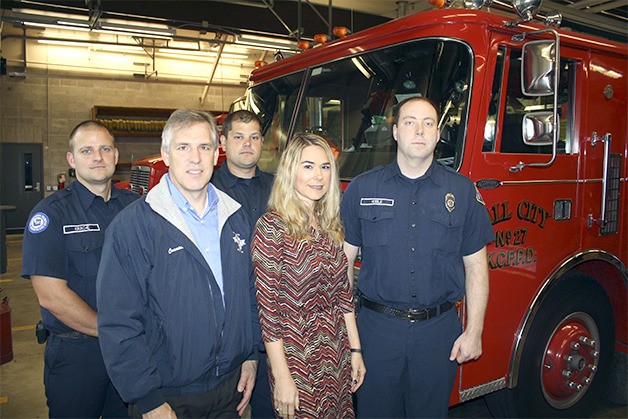You don’t just hop in a hovercraft and zoom away.
“It takes a lot of training to be able to operate it,” explains firefighter Brett Krache, as he shows me the Fall City Fire District’s big fan-powered rescue craft.
In some situations, like floods, it’s too dangerous to ply the Snoqualmie River with an outboard motor. So the department trains at ballfields and the river with the hovercraft. And that takes time.
“We can’t put ourselves out of service to go train,” said Krache. “For us to really dive into the training, we need help.”
For a real deep-drive into new skills, from attacking a high, burning building to saving a drowning man, volunteers or Fall City’s paid firefighters need time and resources. But economics are putting Fall City’s elective training, community service and the staff itself against the wall.
The district is pushing back with its first maintenance and operations levy, on the general election ballot for the 6,000 residents of District 27.
Proposition 1 would collect $450,000 a year, over three years, at a rate of about 50 cents per $1,000 in assessed property value. Funds will be used to maintain service levels and retain its 10 paid firefighters.
To pass, it needs a 60 percent “yes” vote and turnout of at least 733 people.
Falling revenues
In 2010, the district saw its assessed values decline by a fifth after neighborhoods in the Montaine and Aldarra areas to the east were annexed into Sammamish.
“That first year, we took a $120,000 hit,” said Eric Hollis, commissioner for Fire District 27’s position 2.
Between the loss of territory and falling values, the district experienced a 42 percent decline in the value of what it can levy since 2009. It expects a shortfall of $388,000 this year, with similar deficits over the next three years.
Call volumes have not changed due to the annexation because of mutual aid agreements, say firefighters. They still run calls in the area, as they’re often the closest unit. But fire tax dollars go to the city of Sammamish.
“Almost everyone we talk to supports the levy once they understand the dynamics of our situation,” said firefighter Patrick LeDoux. “We have always had good support from our community and I know that they appreciate the services we provide. We are hopeful that this levy passes, so we can continue the services that they expect.”
If things don’t change, the district is on track to lay off three firefighters, cut furlough days and training and put off equipment and vehicle replacement.
In July, District 27 commissioners voted to put a measure on the ballot for new revenues.
Lilly Hansen, commissioner for position 1, said there was a lot of discussion on what and how much to ask for, but the decision to go to the polls was unanimous.
Her decision was easy, “because it’s desperately needed,” Hansen said. “There will be some drastic changes if it doesn’t pass.”
For firefighters, the loss of training equals a loss in safety.
When the district scales back education for wildland firefighting, high-angle roof and river rescues, the ability to respond could follow.
“If we can’t train on it, we can’t do it,” said firefighter Joe Springer. “It’s just not safe.”
To Hollis, this levy is about staffing to the basic level, being able to respond to the “life-saving events,” such as medical calls or car accidents, that happen about twice every day,
“We need to be able to hold the line,” he said.
“There’s safety in numbers. If the levy fails, we have to lay off 30 percent of our members,” said Krache. “That layoff is going to decrease the safety of our members as well as citizens.”
Fall prevention programs, CPR classes, school visits and other community service activities are on the block, too. Cuts would focus Fall City on the basics: Fire suppression and emergency medical response.
“A lot of the things we do around here are elective,” said Krache.
The district relies on a successful volunteer program that ensures citizen-responders at nights and on busy summer weekends. But volunteer training isn’t free, either.
“The requirements to be a firefighter and EMT,” or emergency medical technician, “the training, has gone up so much,” Krache tells me. “We bring in volunteers whenever we possibly can. But they have jobs. And it’s hard to get people to come down on their time off.”
River rescues don’t happen very often. But when they do, they’re risky.
If Fall City’s team isn’t trained to handle them, that means a wait of at least six minutes as they wait for a neighboring squad from Snoqualmie, Carnation or Duvall to arrive.
“We all want to be able to help people,” Krache said. “If we don’t have expert training, we’re putting ourselves at risk.”
New truck
The levy also pays to replace the station’s 1980 Pierce Lance fire engine, the oldest vehicle at the station. By the latest industry standards, firefighters say, the 23-year-old Lance is outmoded. The engine is still clean and shiny, but it doesn’t stop as fast or have all the capabilities of the other engines parked in Fall City’s bay.
“It’s been well taken care of,” said Springer. “We’re just not going to be able to use it anymore.”
• You can learn more about Fall City Fire District services at http://king27fire.com.

Brett Krache stands in the Fall City Fire District’s river-rescue hovercraft. The district’s training for special activities, such as rescues, is at stake in budget cuts.


